Evaluation of Landsat-Based METRIC Modeling to Provide High-Spatial Resolution Evapotranspiration Estimates for Amazonian Forests
Abstract
:1. Introduction
2. Materials and Methods
2.1. Sites and Flux Tower Data
2.2. METRIC Evapotranspiration
2.2.1. Selection of Cold and Hot Pixels
2.2.2. METRIC Parameterization for Forest Application
2.2.3. Seasonal and Monthly ET Estimates from Daily ETrF Maps
2.2.4. Error Estimation
3. Results
3.1. Energy Balance Closure
3.2. Daily ET from FT and METRIC
3.3. Seasonal ETrF and ET
3.4. Monthly and Seasonal Average ET
4. Discussion
4.1. Challenges in Application of METRIC for Forest ET Estimation in Amazonia
4.2. Potential Benefits and Future Direction of Application of METRIC for Forest ET Estimation in Amazonia
5. Conclusions
Acknowledgments
Author Contributions
Conflicts of Interest
References
- Salati, E.; Nobre, C.A. Possible climatic impacts of tropical deforestation. Clim. Chang. 1991, 19, 177–196. [Google Scholar] [CrossRef]
- Victoria, R.L.; Martinelli, L.A.; Mortatti, J.; Richey, J. Mechanisms of water recycling in the Amazon basin: Isotopic insights. Ambio 1991, 20, 384–387. [Google Scholar]
- D’Almeida, C.; Vorosmarty, C.J.; Hurtt, G.C.; Marengo, J.A.; Dingman, S.L.; Keim, B.D. The effects of deforestation on the hydrological cycle in Amazonia: A review on scale and resolution. Int. J. Climatol. 2007, 27, 633–647. [Google Scholar] [CrossRef]
- Hasler, N.; Avissar, R. What controls evapotranspiration in the Amazon basin? J. Hydrometeorol. 2007, 8, 380–395. [Google Scholar] [CrossRef]
- Da Rocha, H.R.; Manzi, A.O.; Cabral, O.M.; Miller, S.D.; Goulden, M.L.; Saleska, S.R.; Coupe, N.R.; Wofsy, S.C.; Borma, L.S.; Artaxo, P.; et al. Patterns of water and heat flux across a biome gradient from tropical forest to savanna in Brazil. J. Geophys. Res. Biogeosci. 2009, 114. [Google Scholar] [CrossRef] [Green Version]
- Costa, M.H.; Biajoli, M.C.; Sanches, L.; Malhado, A.C.M.; Hutyra, L.R.; da Rocha, H.R.; Aguiar, R.G.; de Araujo, A.C. Atmospheric versus vegetation controls of Amazonian tropical rain forest evapotranspiration: Are the wet and seasonally dry rain forests any different? J. Geophys. Res. Biogeosci. 2010, 115. [Google Scholar] [CrossRef]
- Werth, D.; Avissar, R. The regional evapotranspiration of the Amazon. J. Hydrometeorol. 2004, 5, 100–109. [Google Scholar] [CrossRef]
- Bastiaanssen, W.G.M. Regionalization of Surface Flux Densities and Moisture Indicators in Composite Terrain: A Remote Sensing Approach under Clear Skies in Mediterranean Cimates. Ph.D. Thesis, CIP Data Koninklijke Bibliotheek, Den Haag, The Netherlands, 1995. [Google Scholar]
- Allen, R.G.; Tasumi, M.; Morse, A.; Trezza, R.; Wright, J.L.; Bastiaansseen, W.; Kramber, W.; Lorite, I.; Robison, C. Satellite-based energy balance for mapping evapotranspiration with internalized calibration (METRIC)–Applications. J. Irrig. Drain. Eng. 2007, 133, 395–406. [Google Scholar] [CrossRef]
- Kalma, J.D.; McVicar, T.R.; McCabe, M.F. Estimating Land Surface Evaporation: A Review of Methods Using Remotely Sensed Surface Temperature Data. Surv. Geophys. 2008, 29, 421–469. [Google Scholar] [CrossRef]
- Anderson, M.C.; Allen, R.G.; Morse, A.; Kustas, W.P. Use of Landsat thermal imagery in monitoring evapotranspiration and managing water resources. Remote Sens. Environ. 2012, 122, 50–65. [Google Scholar] [CrossRef]
- Gowda, P.H.; Chavez, J.L.; Colaizzi, P.D.; Evett, S.R.; Howell, T.A.; Tolk, J.A. Remote sensing based energy balance algorithms for mapping ET: Current status and future challenges. Trans. Am. Soc. Agric. Biol. Eng. 2007, 5, 1639–1644. [Google Scholar]
- Allen, R.; Irmak, A.; Trezza, R.; Hendrickx, J.M.H.; Bastiaanssen, W.; Kjaersgaard, J. Satellite-based ET estimation in agriculture using SEBAL and METRIC. Hydrol. Process. 2011, 25, 4011–4027. [Google Scholar] [CrossRef]
- Mu, Q.; Heinsch, F.A.; Zhao, M.; Running, S.W. Development of a global evapotranspiration algorithm based on MODIS and global meteorology data. Remote Sens. Environ. 2007, 111, 519–536. [Google Scholar] [CrossRef]
- Mu, Q.Z.; Zhao, M.S.; Running, S.W. Improvements to a MODIS global terrestrial evapotranspiration algorithm. Remote Sens. Environ. 2011, 115, 1781–1800. [Google Scholar] [CrossRef]
- Laurance, W.F.; Camargo, J.L.C.; Luizao, R.C.C.; Laurance, S.G.; Pimm, S.L.; Bruna, E.M.; Stouffer, P.C.; Williamson, G.B.; Benitez-Malvido, J.; Vasconcelos, H.L.; et al. The fate of Amazonian forest fragments: A 32-year investigation. Biol. Conserv. 2011, 144, 56–67. [Google Scholar] [CrossRef]
- Roy, S.B. Mesoscale moisture transport effects on forest edges in a fragmented landscape in Amazonia. Clim. Chang. 2011, 108, 609–617. [Google Scholar]
- Allen, R.G. Using the FAO-56 dual crop coefficient method over an irrigated region as part of an evapotranspiration intercomparison study. J. Hydrol. 2000, 229, 27–41. [Google Scholar] [CrossRef]
- Allen, R.G.; Clemmens, A.J.; Burt, C.M.; Solomon, K.; O’Halloran, T. Prediction accuracy for projectwide evapotranspiration using crop coefficients and reference evapotranspiration. J. Irrig. Drain. Eng. 2005, 131, 24–36. [Google Scholar] [CrossRef]
- Allen, R.G.; Tasumi, M.; Trezza, R. Satellite-based energy balance for mapping evapotranspiration with internalized calibration (METRIC)—Model. J. Irrig. Drain. Eng. 2007, 133, 380–394. [Google Scholar] [CrossRef]
- Bastiaanssen, W.G.M. SEBAL-based sensible and latent heat fluxes in the irrigated Gediz Basin, Turkey. J. Hydrol. 2000, 229, 87–100. [Google Scholar] [CrossRef]
- Environmental and Water Resources Institute of the American Society of Civil Engineers (ASCE-EWRI). The ASCE Standardized Reference Evapotranspiration Equation; Report of the ASCE-EWRI Task Committee on Standardization of Reference Evapotranspiration; ASCE: Reston, VA, USA, 2005. [Google Scholar]
- Trezza, R.; Allen, R.G.; Tasumi, M. Estimation of actual evapotranspiration along the Middle Rio Grande of New Mexico using MODIS and Landsat imagery with the METRIC model. Remote Sens. 2013, 5, 5397–5423. [Google Scholar] [CrossRef]
- Bhattarai, N.; Quackenbush, L.J.; Dougherty, M.; Marzen, L.J. A simple Landsat-MODIS fusion approach for monitoring seasonal evapotranspiration at 30 m spatial resolution. Int. J. Remote Sens. 2015, 36, 115–143. [Google Scholar] [CrossRef]
- Carrilo-Rojas, G.; Silva, B.; Córdova, M.; Célleri, R.; Bendix, J. Dynamic mapping of evapotranspiration using an energy balance-based model over an Andean Páramo Catchment of Southern Ecuador. Remote Sens. 2016, 8, 160. [Google Scholar] [CrossRef]
- McWilliam, A.L.C.; Cabral, M.R.; Gomes, B.M.; ESteves, J.L.; Roberts, J.M. Forest and pasture leaf-gas exchange in south-west Amazonia. In Amazonian Deforestation and Climate; Gash, J.H.C., Nobre, C.A., Robert, J.M., Victoria, R.L., Eds.; John Wiley & Sons: Chichester, NY, USA, 1996; pp. 265–285. [Google Scholar]
- Numata, I.; Roberts, D.A.; Chadwick, O.A.; Schimel, J.P.; Sampaio, F.F.; Leonidas, F.C.; Soares, J.V. Characterization of pasture biophysical properties and the impact of grazing intensity using remotely sensed data. Remote Sens. Environ. 2007, 108, 314–327. [Google Scholar] [CrossRef]
- Oak Ridge National Laboratory Distributed Active Archive Center. LBA-ECO CD-32 Flux Tower Network Data Compilation, Brazilian Amazon: 1999–2006. Available online: http://daac.ornl.gov/LBA/guides/CD32_Brazil_Flux_Network.html (accessed on 1 February 2015).
- Von Randow, C.; Manzi, A.O.; Kruijt, B.; de Oliveira, P.J.; Zanchi, F.B.; Silva, R.L.; Hodnett, M.G.; Gash, J.H.C.; Elbers, J.A.; Waterloo, M.J.; et al. Comparative measurements and seasonal variations in energy and carbon exchange over forest and pasture in south west Amazonia. Theor. Appl. Climatol. 2004, 78, 5–26. [Google Scholar] [CrossRef]
- Saleska, S.R.; Miller, S.D.; Matross, D.M.; Goulden, M.L.; Wofsy, S.C.; da Rocha, H.R.; de Camargo, P.B.; Crill, P.; Daube, B.C.; de Freitas, H.C.; et al. Carbon in Amazon forests: Unexpected seasonal fluxes and disturbance-induced losses. Science 2003, 302, 1554–1557. [Google Scholar] [CrossRef] [PubMed]
- Araujo, A.C.; Nobre, A.D.; Kruijt, B.; Elbers, J.A.; Dallarosa, R.; Stefani, P.; von Randow, C.; Manzi, A.O.; Culf, A.D.; Gash, J.H.C.; et al. Comparative measurements of carbon dioxide fluxes from two nearby towers in a central Amazonian rainforest: The Manaus LBA site. J. Geophys. Res. Atmos. 2002, 107. [Google Scholar] [CrossRef]
- Goulden, M.L.; Miller, S.D.; da Rocha, H.R.; Menton, M.C.; de Freitas, H.C.; Figueira, A.M.E.S.; de Sousa, C.A.D. Diel and seasonal patterns of tropical forest CO2 exchange. Ecol. Appl. 2004, 14, S42–S54. [Google Scholar] [CrossRef]
- Twine, T.E.; Kustas, W.P.; Norman, J.M.; Cook, D.R.; Houser, P.R.; Meyers, T.P.; Prueger, J.H.; Starks, P.J.; Wesely, M.L. Correcting eddy-covariance flux underestimates over a grassland. Agric. For. Meteorol. 2000, 103, 279–300. [Google Scholar] [CrossRef]
- Wilson, K.; Goldstein, A.; Falge, E.; Aubinet, M.; Baldocchi, D.; Berbigier, P.; Bernhofer, C.; Ceulemans, R.; Dolman, H.; Field, C.; et al. Energy balance closure at fluxnet sites. Agric. For. Meteorol. 2002, 113, 223–243. [Google Scholar] [CrossRef]
- Tasumi, M.; Allen, R.G.; Trezza, R.; Wright, J.L. Satellite-based energy balance to assess with in-population variance of crop coefficient curves. J. Irrig. Drain. Eng. 2005, 131, 94–109. [Google Scholar] [CrossRef]
- Allen, R.; Trezza, R.; Tasumi, M.; Kjaersgaard, J. METRIC: Mapping Evapotranspiration at High Resolution Using Internalized Calibration Applications Manual for Landsat Satellite Imagery, V 3.0.; University of Idaho: Moscow, ID, USA, 2014; 279.
- Dhungel, R.; Allen, R.G.; Trezza, R. Improving iterative surface energy balance convergence for remote sensing based flux calculations. J. Appl. Remote Sens. 2016, 10, 026033. [Google Scholar] [CrossRef]
- Allen, R.G.; Pereira, L.S.; Raes, D.; Smith, M. Crop Evapotranspiration—Guidelines for Computing Crop Water Requirements—FAO Irrigation and Drainage Paper 56; Food and Agriculture Organization of the United Nations: Rome, Italy, 1998. [Google Scholar]
- Kjaersgaard, J.; Allen, R.; Irmak, A. Improved methods for estimating monthly and growing season ET using METRIC applied to moderate resolution satellite imagery. Hydrol. Process. 2011, 25, 4028–4036. [Google Scholar] [CrossRef]
- Perrier, A. Land surface process: Vegetation. In Land Surface Process in Atmospheric General Circulation Models; Eagelson, P., Ed.; Cambridge University Press: Cambridge, UK, 1982; pp. 395–448. [Google Scholar]
- Souza, C.M.; Siqueira, J.V.; Sales, M.H.; Fonseca, A.V.; Ribeiro, J.G.; Numata, I.; Cochrane, M.A.; Barber, C.P.; Roberts, D.A.; Barlow, J. Ten-year Landsat classification of deforestation and forest degradation in the Brazilian Amazon. Remote Sens. 2013, 5, 5493–5513. [Google Scholar] [CrossRef]
- Long, D.; Singh, V.P. Assessing the impact of end-member selection on the accuracy of satellite-based spatial variability models for actual evapotranspiration estimation. Water Resour. Res. 2013, 49, 2601–2618. [Google Scholar] [CrossRef]
- Cammalleri, C.; Anderson, M.C.; Gao, F.; Hain, C.R.; Kustas, W.P. Mapping daily evapotranspiration at field scales over rainfed and irrigated agricultural areas using remote sensing data fusion. Agric. For. Meteorol. 2014, 186, 1–11. [Google Scholar] [CrossRef]
- Semmens, K.A.; Anderson, M.C.; Kustas, W.P.; Gao, F.; Alfieri, J.G.; McKee, L.; Prueger, J.H.; Hain, C.R.; Cammalleri, C.; Yang, Y.; Xia, T. Monitoring daily evapotranspiration over two California vineyards using Landsat 8 in a multi-sensor data fusion approach. Remote Sens. Environ. 2016, 185, 155–170. [Google Scholar] [CrossRef]
- Dhungel, R.; Allen, R.G.; Trezza, R.; Robison, C.W. Evapotranspiration between satellite overpasses: Methodology and case study in agricultural dominant semi-arid areas. Meteorol. Appl. 2016, 23, 714–730. [Google Scholar] [CrossRef]
- Da Rocha, H.R.; Goulden, M.L.; Miller, S.D.; Menton, M.C.; Pinto, L.D.V.O.; de Freitas, H.C.; Figueira, A.M.E.S. Seasonality of water and heat fluxes over a tropical forest in eastern Amazonia. Ecol. Appl. 2004, 14, S22–S32. [Google Scholar] [CrossRef]
- Singh, R.K.; Irmak, A. Treatment of anchor pixels in the METRIC model for improved estimation of sensible and latent heat fluxes. Hydrol. Sci. J. 2011, 56, 895–906. [Google Scholar] [CrossRef]
- Asner, G.P. Cloud cover in Landsat observations of the Brazilian Amazon. Int. J. Remote Sens. 2001, 22, 3855–3862. [Google Scholar] [CrossRef]
- Senay, G.B.; Gowda, P.H.; Bohms, S.; Howell, T.A.; Friedrichs, M.; Marek, T.H.; Verdin, J.P. Evaluating the SSEBop approach for evapotranspiration mapping with Landsat data using lysimetric observations in the semi-arid Texas High Plains. Hydrol. Earth Syst. Sci. Discuss. 2014, 11, 723–756. [Google Scholar] [CrossRef]
- Senay, G.B.; Bohms, S.; Singh, R.K.; Gowda, P.H.; Velpuri, N.M.; Alemu, H.; Verdin, J.P. Operational evapotranspiration mapping using remote sensing and weather datasets: A new parameterization for the SSEB approach. J. Am. Water Resour. Assoc. 2013, 49, 577–591. [Google Scholar] [CrossRef]
- Su, Z. The surface energy balance systems (SEBS) for estimation of turbulent fluxes. Hydrol. Earth Syst. Sci. 2002, 6, 85–99. [Google Scholar] [CrossRef]
- Singh, R.K.; Senay, G.B.; Velpuri, N.M.; Bohms, S.; Scott, R.L.; Verdin, J.R. Actual evapotranspiration (water use) assessment of the Colorado river basin at the Landsat resolution using the operational simplified surface energy balance model. Remote Sens. 2014, 6, 233–256. [Google Scholar] [CrossRef]
- Roerink, G.J.; Su, Z.; Menenti, M. S-SEBI: A simple remote sensing algorithm to estimate the surface energy balance. Phys. Chem. Earth Part B 2000, 25, 147–157. [Google Scholar] [CrossRef]
- Ringgaard, R.; Herbst, M.; Friborg, T. Partitioning of forest evapotranspiration: The impact of edge effects and canopy structure. Agric. For. Meteorol. 2012, 166, 86–97. [Google Scholar] [CrossRef]
- Foken, T. Micrometeorology; Springer: Berlin, Germany, 2008. [Google Scholar]
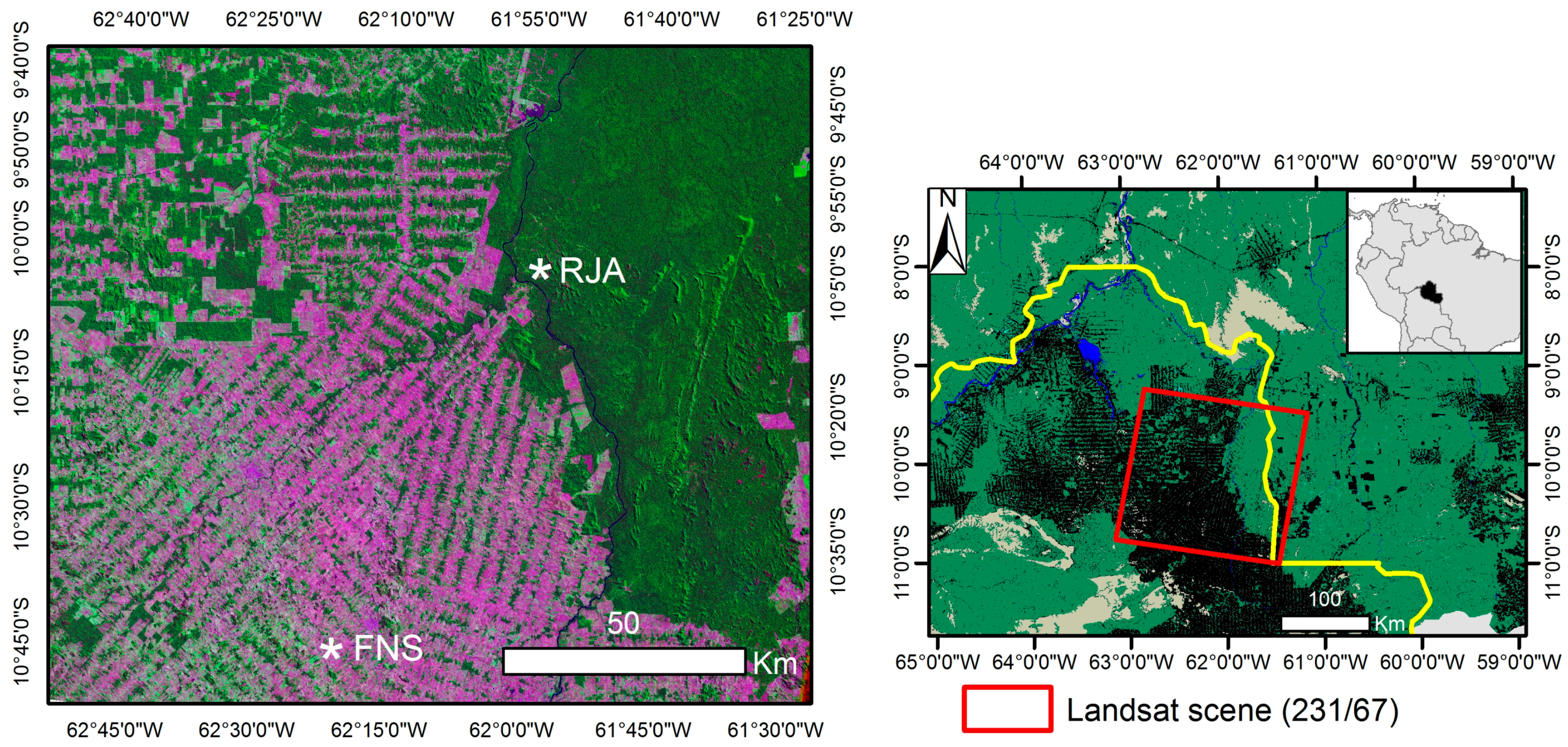
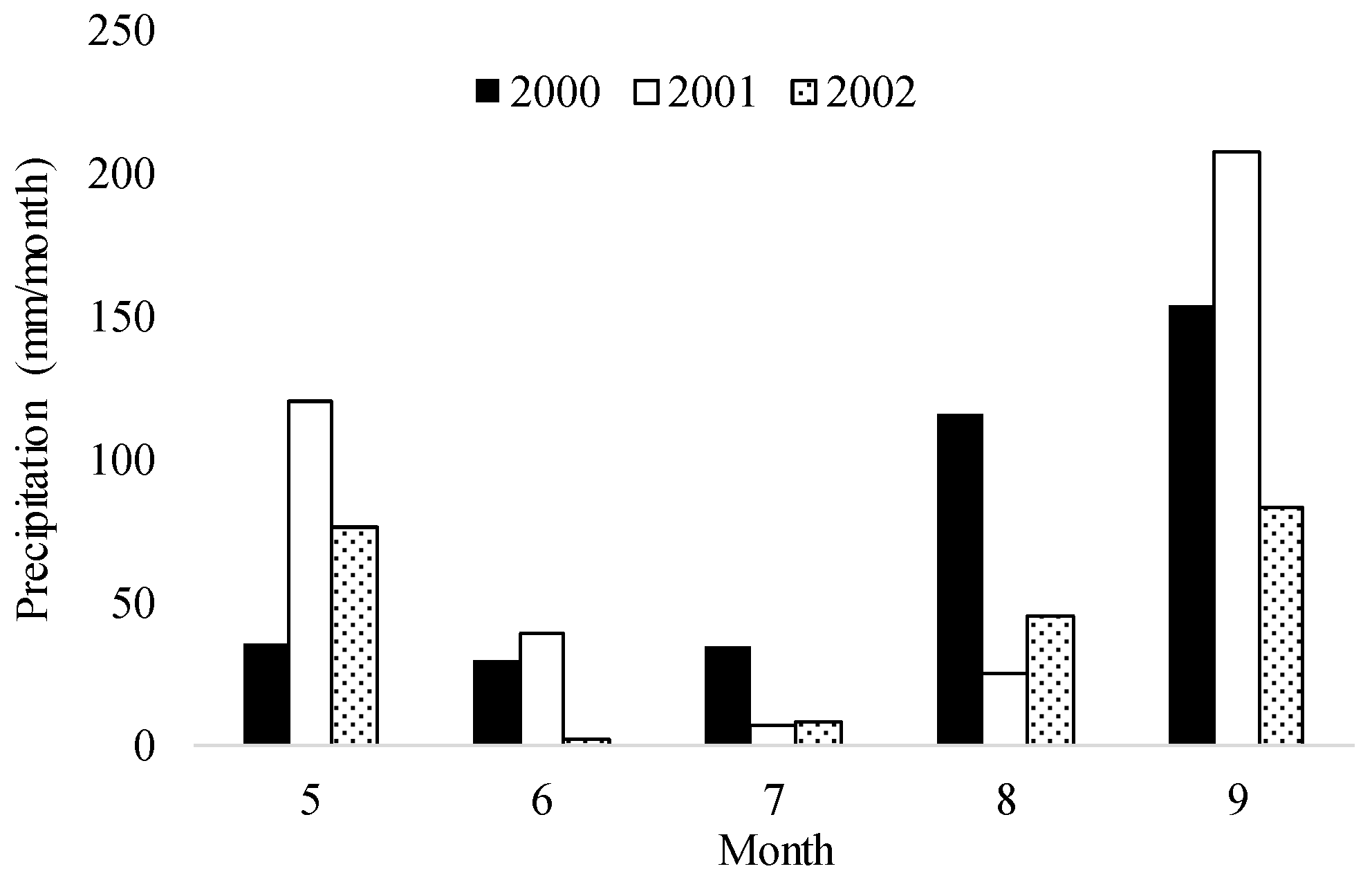
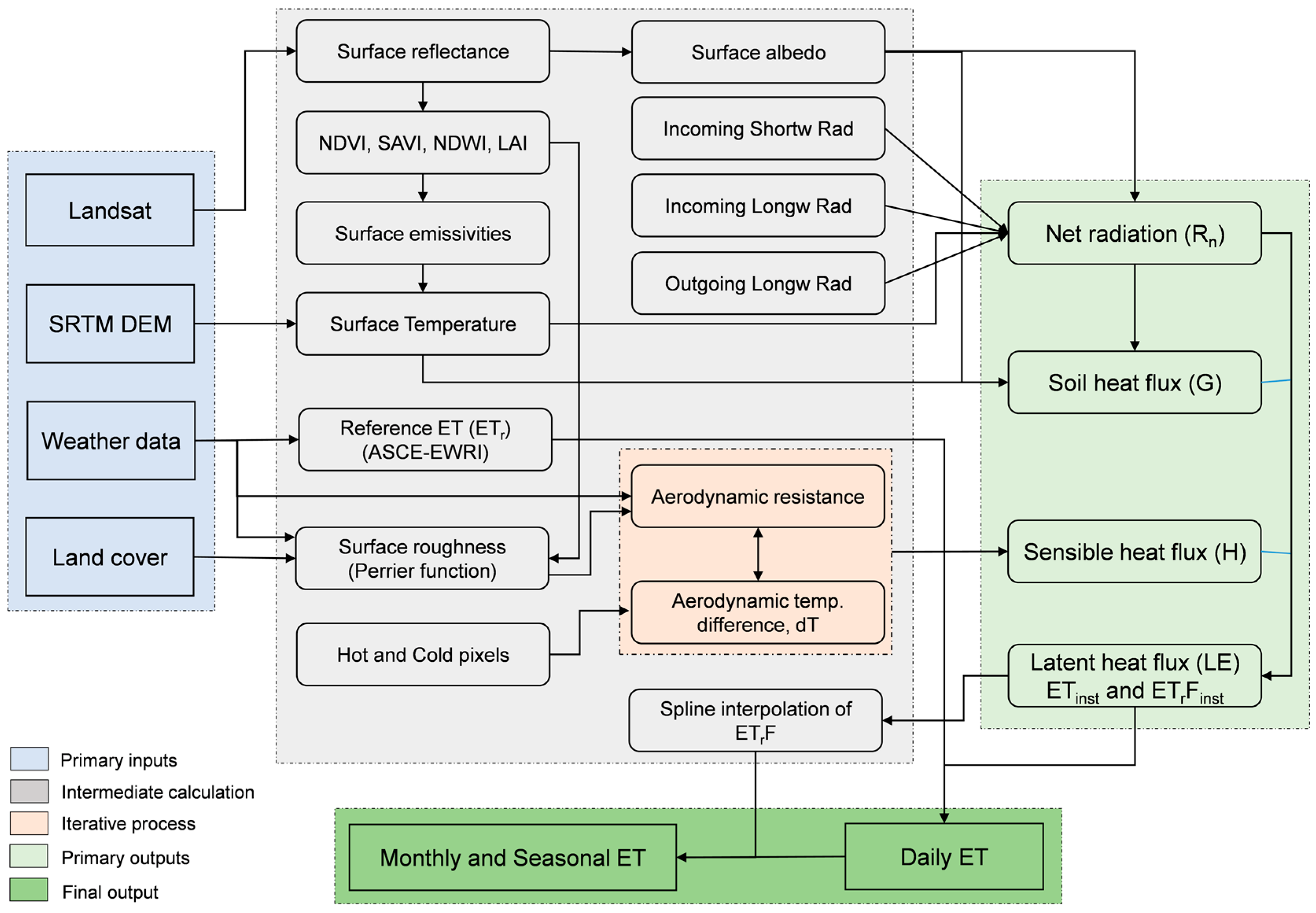

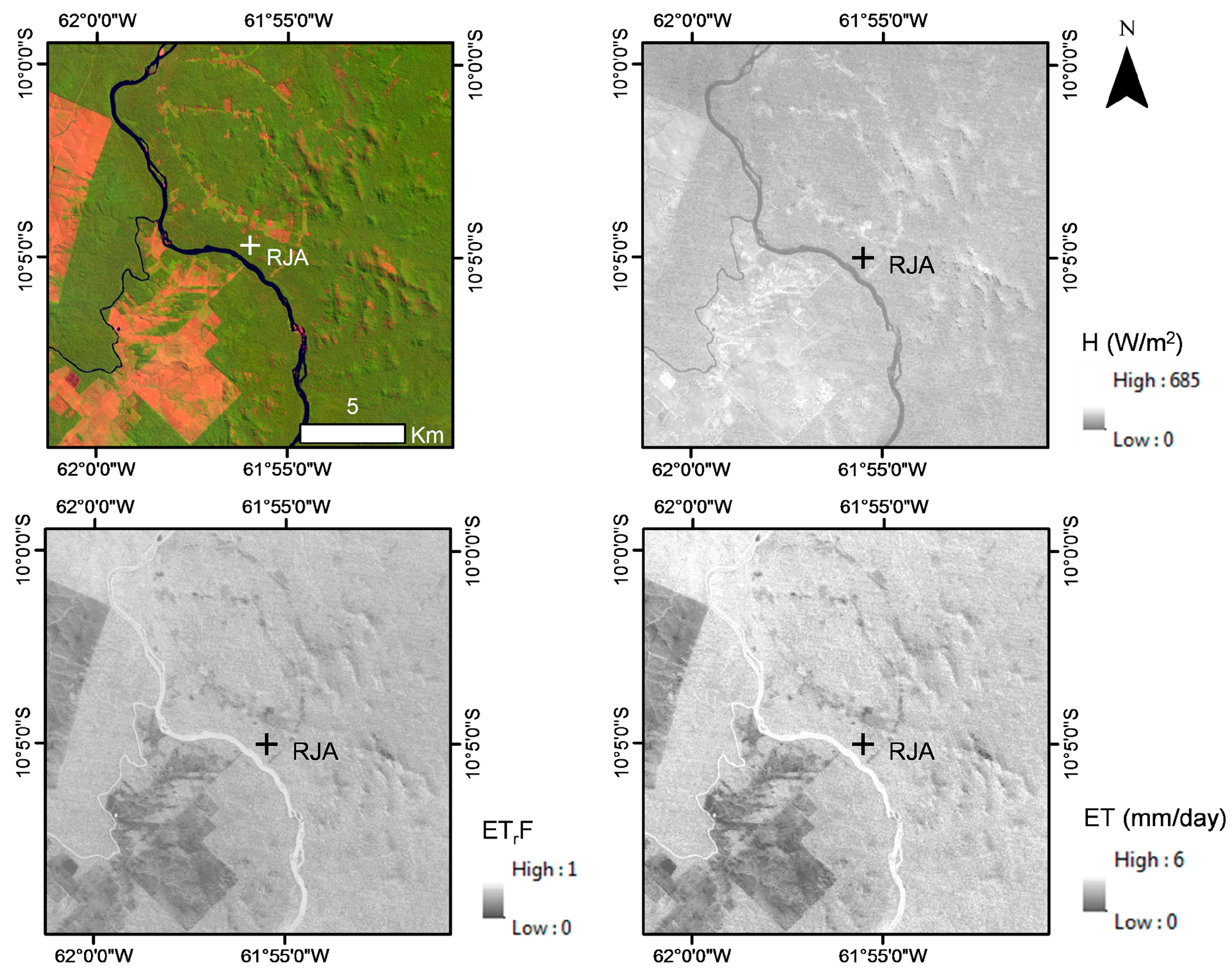
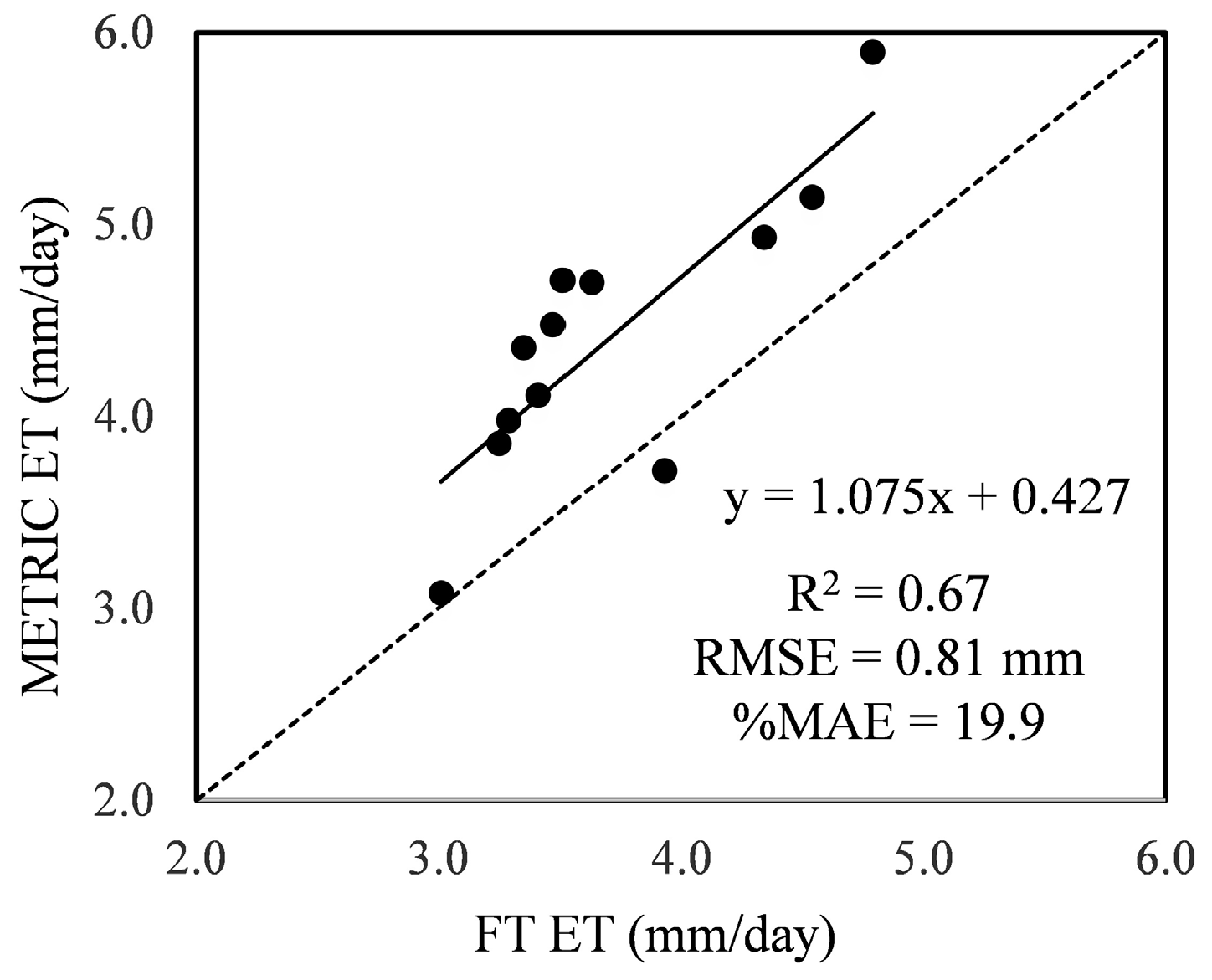
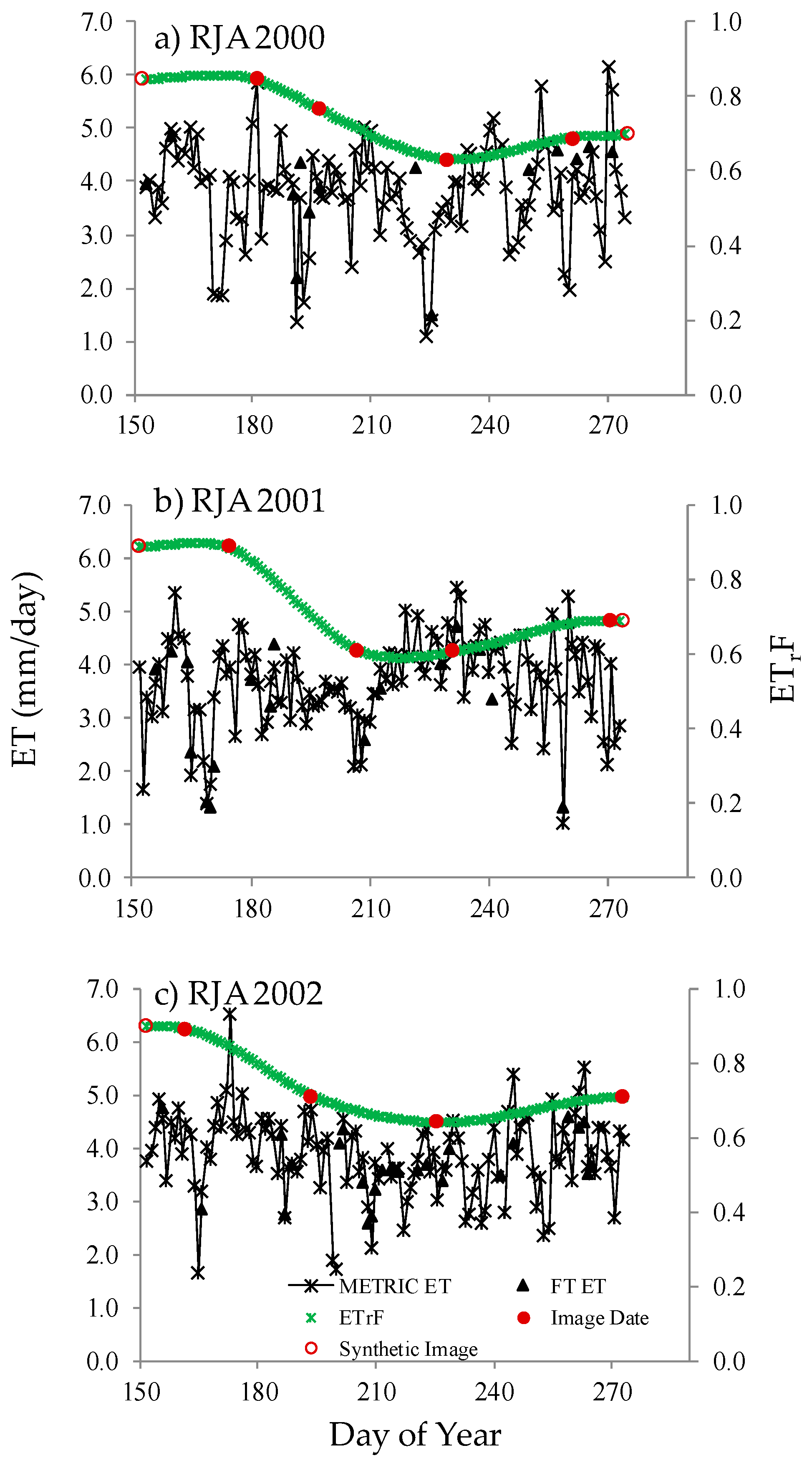
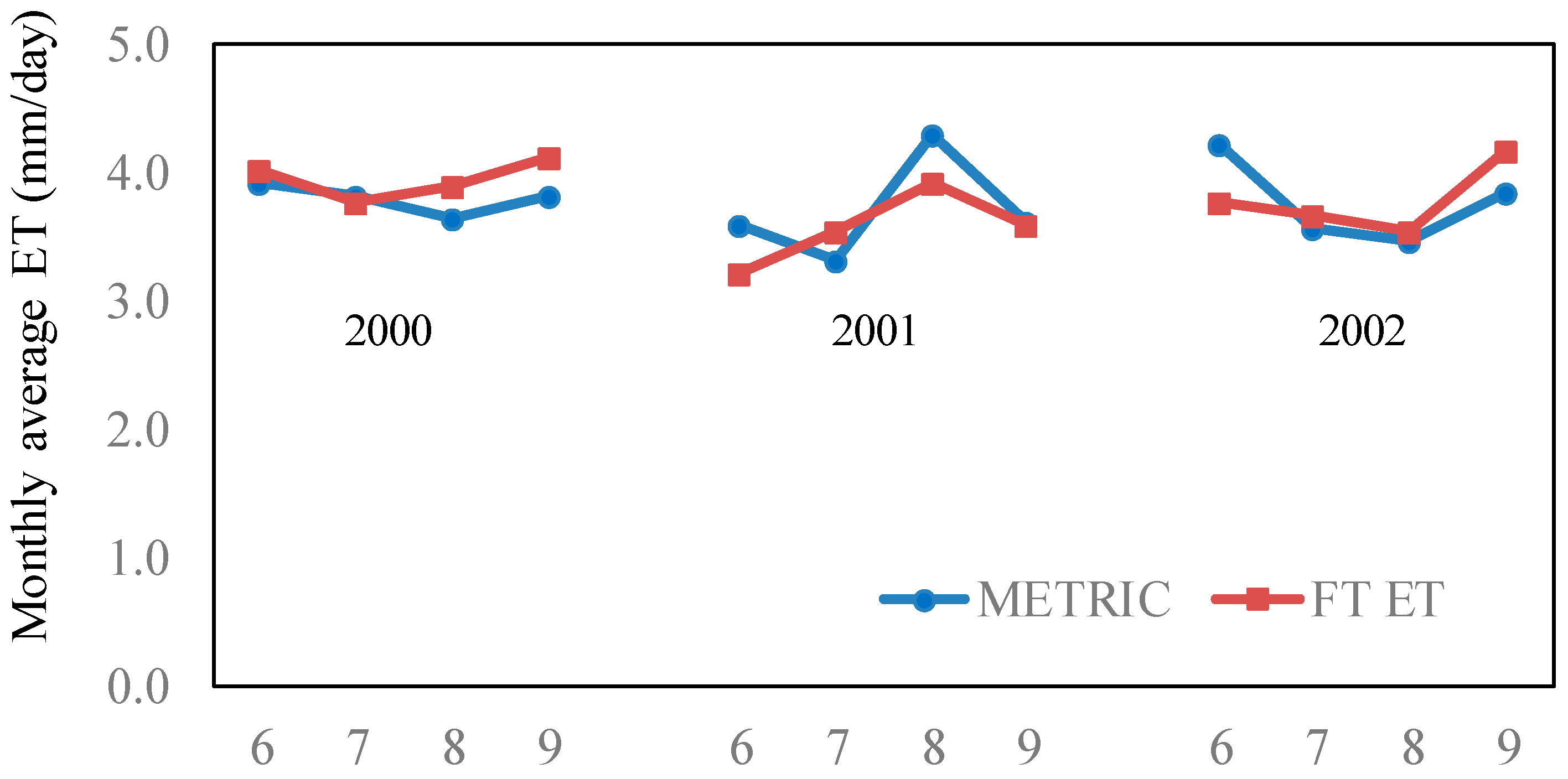

| Site | Location (Latitude S, Longitude W) | Biome Type | Instrument Height (m) | Canopy Height (m) | Period of Data Used |
|---|---|---|---|---|---|
| RJA | Reserva Jarú (RJA), Rondônia (10.08, 61.93) | Tropical semideciduous forest | 60 | 30 | 2000–2002 |
| FNS | Fazenda Nossa Senhora, Rondônia (10.76, 62.35) | Pasture | 10 | 0.5 | 2000–2002 |
| Year | Avg ETr | Max ETr | Min ETr | Tavg | Tmax | Tmin | Wavg | Wmax | Wmin |
|---|---|---|---|---|---|---|---|---|---|
| 2000 | 5.2 | 8.9 | 1.7 | 24.6 | 28.5 | 13.0 | 3.0 | 9.7 | 1.4 |
| 2001 | 5.3 | 9.0 | 1.6 | 24.9 | 28.7 | 12.9 | 2.6 | 8.0 | 1.2 |
| 2002 | 5.3 | 8.2 | 1.9 | 25.7 | 28.1 | 20.2 | 2.7 | 6.5 | 1.3 |
| Path/Row | Site | Date * | Satellite |
|---|---|---|---|
| 231/67 | RJA | 5/31/2000 (C) | synthetic image |
| 231/67 | RJA | 6/29/2000 (C, D) | Landsat 5 |
| 231/67 | RJA | 7/15/2000 (C, D) | Landsat 5 |
| 231/67 | RJA | 8/16/2000 (C) | Landsat 5 |
| 231/67 | RJA | 8/24/2000 (D) | Landsat 7 |
| 231/67 | RJA | 9/17/2000 (C, D) | Landsat 5 |
| 231/67 | RJA | 10/1/2000 (C) | synthetic image |
| 231/67 | RJA | 5/31/2001 (C) | synthetic image |
| 231/67 | RJA | 6/8/2001 (D) | Landsat 7 |
| 231/67 | RJA | 6/24/2001 (C, D) | Landsat 7 |
| 231/67 | RJA | 7/26/2001 (C, D) | Landsat 7 |
| 231/67 | RJA | 8/19/2001 (C, D) | Landsat 5 |
| 231/67 | RJA | 9/28/2001 (C) | Landsat 7 |
| 231/67 | RJA | 10/1/2001 (C) | synthetic image |
| 231/67 | RJA | 5/31/2002 (C) | synthetic image |
| 231/67 | RJA | 6/11/2002 (C, D) | Landsat 7 |
| 231/67 | RJA | 6/27/2002 (D) | Landsat 7 |
| 231/67 | RJA | 7/13/2002 (C, D) | Landsat 7 |
| 231/67 | RJA | 7/29/2002 (D) | Landsat 7 |
| 231/67 | RJA | 8/14/2002 (C) | Landsat 7 |
| 231/67 | RJA | 10/1/2002 (C) | Landsat 7 |
| Year | No. of Days with Available Data (% of Days in Year) | r2 for Rn − G vs. H + LE | (H + LE)/(Rn − G) |
|---|---|---|---|
| 2000 | 174 (48%) | 0.60 | 0.67 |
| 2001 | 261 (71%) | 0.76 | 0.70 |
| 2002 | 185 (51%) | 0.58 | 0.75 |
| Location | Year | No. of Dates | a | B | r2 | RMSE | %MAE |
|---|---|---|---|---|---|---|---|
| RJA | 2000 | 13 | 0.73 | 1.32 | 0.78 | 0.66 | 13.8 |
| RJA | 2001 | 19 | 0.89 | 0.24 | 0.84 | 0.50 | 12.2 |
| RJA | 2002 | 22 | 0.65 | 1.17 | 0.71 | 0.47 | 9.7 |
© 2017 by the authors; licensee MDPI, Basel, Switzerland. This article is an open access article distributed under the terms and conditions of the Creative Commons Attribution (CC-BY) license (http://creativecommons.org/licenses/by/4.0/).
Share and Cite
Numata, I.; Khand, K.; Kjaersgaard, J.; Cochrane, M.A.; Silva, S.S. Evaluation of Landsat-Based METRIC Modeling to Provide High-Spatial Resolution Evapotranspiration Estimates for Amazonian Forests. Remote Sens. 2017, 9, 46. https://doi.org/10.3390/rs9010046
Numata I, Khand K, Kjaersgaard J, Cochrane MA, Silva SS. Evaluation of Landsat-Based METRIC Modeling to Provide High-Spatial Resolution Evapotranspiration Estimates for Amazonian Forests. Remote Sensing. 2017; 9(1):46. https://doi.org/10.3390/rs9010046
Chicago/Turabian StyleNumata, Izaya, Kul Khand, Jeppe Kjaersgaard, Mark A. Cochrane, and Sonaira S. Silva. 2017. "Evaluation of Landsat-Based METRIC Modeling to Provide High-Spatial Resolution Evapotranspiration Estimates for Amazonian Forests" Remote Sensing 9, no. 1: 46. https://doi.org/10.3390/rs9010046






